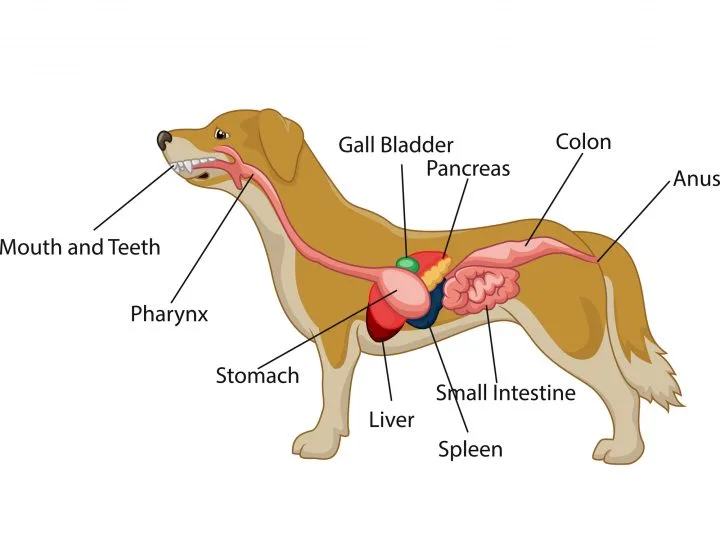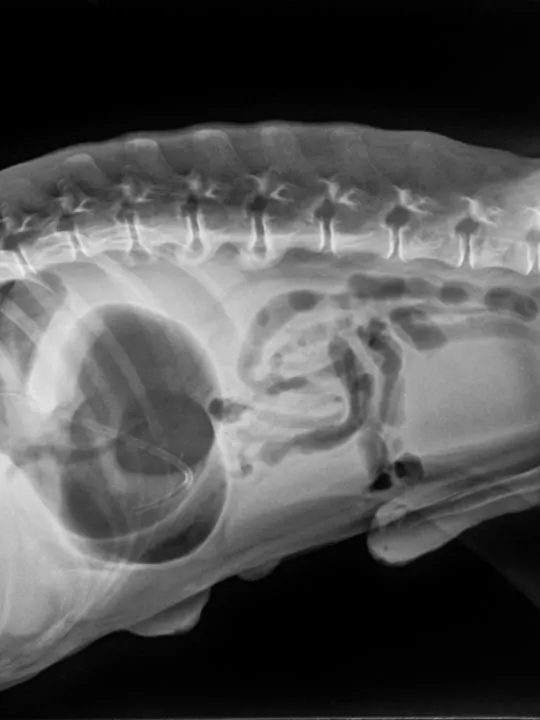When Leroy had his abdominal surgery one of my regrets was not requesting that he have his stomach tacked while they were in there.
It was an afterthought but it would have been the perfect chance to wipe that fear from my plate and protect Leroy from ever experiencing GDV (Gastric Dilatation-Volvulus).
Bloat is every big dog owner’s worse nightmare and if you’re not familiar with it you should definitely take the time to research the condition so that you know the signs of a dog bloating and so that you can take preventative measures.
One of those preventative measures is gastropexy which is a surgery where the dog’s stomach is secured so that it doesn’t twist.
Gastropexy can be performed as elective surgery or it can be done during as emergency surgery after a dog has experienced GDV
What is dog bloat?
Most often referred to as “bloat,” GDV occurs when a dog’s stomach fills up with gas and twists, cutting off blood and oxygen to the stomach.
As the swollen stomach pushes against surrounding organs and large blood vessels, blood flow to the heart eventually stops. Without immediate treatment, shock and a painful death occur will within minutes or hours.

While any dog can develop GDV, large, deep-chested breeds are most affected.
These include, but are not limited, to Great Danes, Saint Bernards, Weimaraners, Irish Setters, Gordon Setters, Standard Poodles, Basset Hounds, NewfoundlandS, Doberman Pinschers, Greater Swiss Mountain Dogs, and Old English Sheepdogs.
What Is Gastropexy?
Gastropexy is a procedure done to prevent gastric torsion in dogs.
Incisional gastropexy
Incisional gastropexy involves suturing together the edges of the inside of the right side of the body wall to the outside of the antrum (bottom of the stomach).
The inside muscle of the body wall is cut, as well as the outside two of the three stomach layers.
The sides of the cut are then sutured between the body wall and stomach.
Initially done by open abdominal surgery, this technique is now is also done laparoscopically.

Belt-loop gastropexy
The Belt-loop gastropexy procedure uses a flap of the stomach to attach the stomach to the right abdominal wall by braiding the stomach flap to strands of the abdominal wall.
An argument against this method, used only with open surgery, is it may not help keep the stomach in place as well as some other gastropexy techniques.
Circumcostal gastropexy
Circumcostal gastropexy uses a flap of the stomach wall to attach the stomach to the last rib on the right side.
An argument in favor of this technique is that the rib is a more rigid and stable part of the anatomy and will likely keep the stomach in place better than the abdominal wall will.
Veterinarian Dr. Rawlings, who developed the technique for laparoscopic-assisted gastropexy several years ago at the University of Georgia College of Veterinary Medicine, believes that these three techniques are effective, with the choice typically based on the surgeon’s experience and preference.
“Many surgeons have developed minor technical modifications for these techniques. The differences between the three are minor.” He says.
Gastropexy has been well-documented to significantly decrease the risk of development of GDV, with rates of occurrence following gastropexy ranging from 0% to 4.3%, regardless of surgical method.

X-ray of dog lateral view with Gastric dilatation volvulus “GDV” or stomach twists- Double bubble pattern indicates stomach torsion has occurred
Recovery Time For Gastropexy
Since preventative gastropexy is normally done at the time of a routine procedure such as a spay or neuter, the recovery time is not longer than a normal recovery period.
Usually, most dogs are allowed to return to normal activity after 7-10 days of restricted activity.
Restricted activity normally consists of no running, jumping, swimming and leash walks to go outside to the bathroom.
No baths until the incision is healed or the veterinarian says otherwise
Gastropexies performed on an emergency basis will require more involved post-operative care, depending on the severity of stomach damage noted during surgery.
Most dogs will remain in the hospital for several days after the procedure and specific after-care will be provided by the veterinarian when the dog goes home.
Risks Of Gastropexy
Besides the general risk of a dog going under anesthesia, not many complications have been documented with preventative gastropexy but emergency gastropexies may see vomiting, diarrhea, regurgitation, inappetence and a tender stomach depending how much of the stomach was compromised during the torsion.
In some cases, if the procedure was not done correcting or it didn’t hold, the stomach could twist.
Always make sure that your veterinarian has experience doing successful gastropexies and if they don’t, consult with another one.
How Much Does Stomach Tacking Cost For A Newfoundland?
The cost to have gastropexy done on a dog will depend on which technique is done and if it is done as a preventative measure or if it’s being done in an emergency situation where the dog is experiencing GDV.
Other factors that will determine the cost of having a dog’s stomach tact will be the size of the dog and other medical procedures that may be taking place such as a spay or hernia repair.
Can A Dog Still Bloat After Having Their Stomach Tacked?
Yes. A dog can still bloat after a gastropexy is done. The tacking of the stomach stops the dangerous part of bloat which is the twisting of the stomach. A dog’s stomach can still fill up with air or food and bloat but as long as the tacking holds, the stomach will not twist.
This gives you, the owner, more time to get the dog to the vet for treatment without the stomach twisting.
Deciding whether your Newfoundland should have gastropexy done is ultimately up to you and the risks that you feel they are faced with bloating.
Recent scientific suggest that dogs with IBD may be at a higher risk for bloating and some studies suggest that dog bloat may be hereditary in certain breeds.
You should always discuss the pros and cons of gastropexy for your dog with your veterinarian and breeder.

Ducky's Mom
Friday 9th of August 2019
Wow, I didn't know standard poodles were at risk for GDV! At the same time, I'm surprised Labs and Goldens aren't on the list considering their deep-chested builds.
BTW, I love the new theme set of the blog!
Tails Around the Ranch
Thursday 8th of August 2019
'Wagnificent' explanation on this life threatening condition. Having owned Standards for the past 17 years and lost one standard to bloat. Was very grateful to know the poodle rescue performed it on Elsa when she was spayed, though it's still my greatest fear.